Adventure
Black Rhino (Diceros bicornis) and White Rhino (Ceratotherium simum)
-Paul McDougall
There are 2 different species of rhino found in Kenya, the black rhino and the white rhino.
Like other hairless mammals rhinos are wallowers. They also dustbathe, rub and scratch
themselves against objects, regularly visit salt licks, and regularly visit swamps. They
alternately rest and feed day and night, being least active and wallowing most when it is hot.
They are generally solitary animals. Rhino territories are dissected by regularly used trails
and scent posted with dung middens used by both sexes. Territorial bulls also mark by urine
spraying.
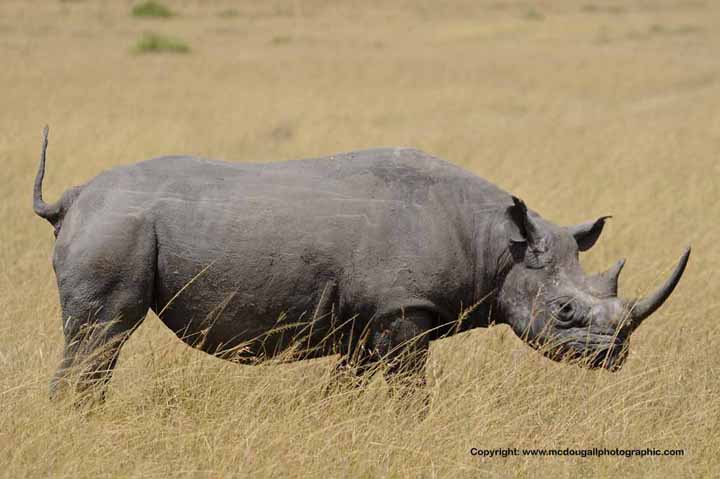
African rhinos have longer horns than their Asian relatives. The white rhino is far less
excitable and dangerous to man than the black rhino. Rhinos make a variety of sounds, from
loud puffing snorts of alarm to high-pitched squeals. Both courtship and mating are prolonged.
Gestation lasts 15-16 months and the single offspring remains with the mother 2 – 4 years.
The Black Rhino is a browser and the White Rhino is a grazer, therefore Black Rhino are found in more dense bush and White Rhinos in more open grassland. The Black Rhino is found in Masai Mara, Lake Nakuru and Tsavo.
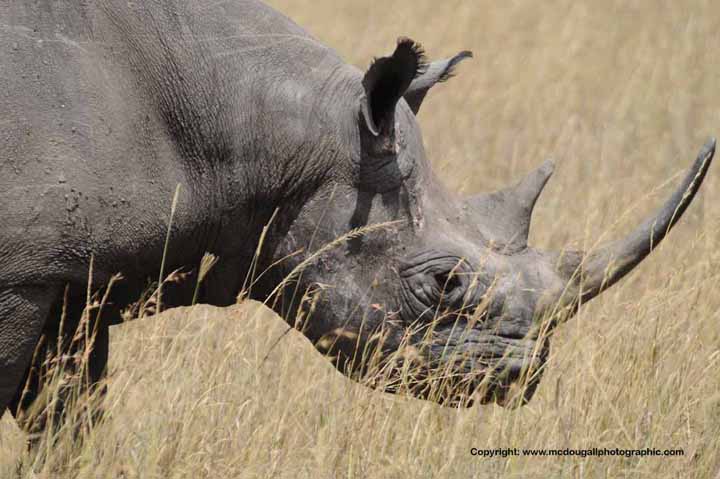
The White Rhino is found in Lake Nakuru NP where a successful breeding programme has taken place and on smaller private ranches in the Laikipia area.
The Black Rhino was formerly the most widespread and numerous rhino. The range and number dwindled steadily with the increased human population. Its decline was accelerated in the 80’s by poaching to meet demand from Arab and Asian countries, and it is rapidly
approaching extinction. Yet all it needs is protection. The White Rhino was practically exterminated but due to a small breeding population in Natal in South Africa which was heavily protected, these animals have been re-introduced to many areas across Africa.
Over the past few years saving the rhino has been a major Kenyan conservation project and there looks to be a successful and happy ending for these intriguing animals.
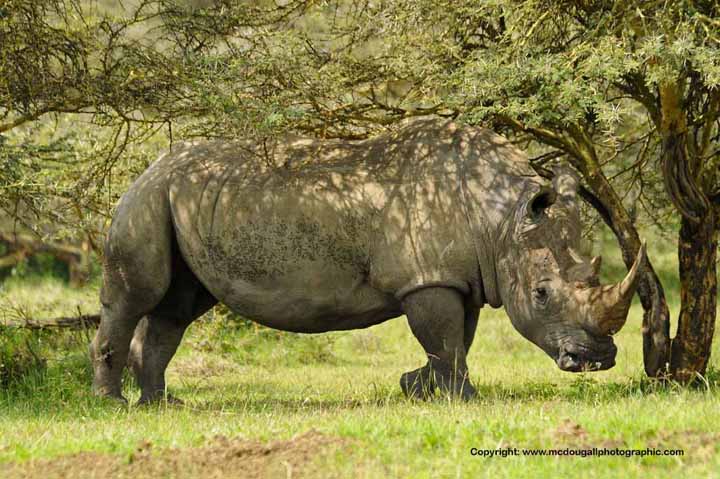
I have been lucky enough to see and photograph both black and white rhinos. 2 experiences stick in my mind, both with Black Rhino in Masai Mara. There are only around 24 Black Rhino in the Mara so it is indeed lucky to even see them. The first experience was
a good one, we say a huge male Black Rhino in the open and just watched it for around an hour walking, eating and scent marking – it really was a pleasure to spend so long with these usually elusive animals.
Black Rhinos can be very bad tempered and aggressive, but this is why I remember this moment.
This rhino was so relaxed and comfortable with us.
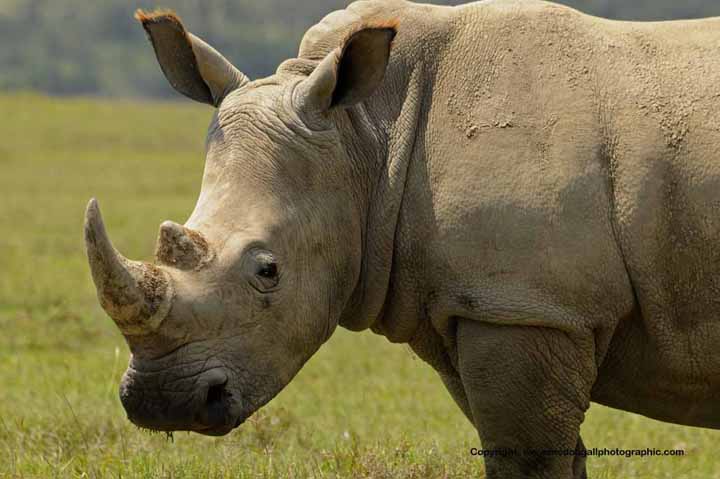
My other memory of a Black Rhino was a complete contrast. We heard on the radio that a rhino had been seen and went to look for it, we soon saw it, but it was running across the open ground, it looked stressed and so we kept our distance and circled behind
it and watched it from afar. It was trying to get to the thick cover of the bushes across the open ground. Unfortunately at the point we circled behind it 4 safari vehicles sped past us and tried to get closer to it, but all they succeeded in doing was blocking
its route to cover, it then got more agitated and charged one vehicle, just missing it, but then it turned and now we were in its view and it charged straight at us, horn down and full on charge. Now that was a scary moment, and I didn’t manage to get any
photographs. Again Black Rhinos are rarely seen in Mara, and this incident shouldn’t have happened, it was caused by a few inexperienced guides that got it so badly wrong that they put everyone in danger, and succeeded in antagonizing this beautiful animal.
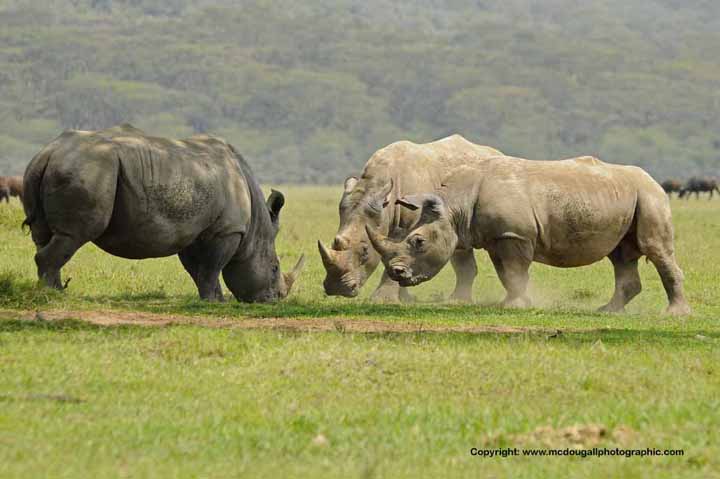
|
Did You Know ?
The future of Europe’s largest genebank, near St Petersburg, has suffered a set-back with the adverse court ruling on 11th Aug, says S.Ananthanarayanan.
The city of St Petersburg has decided to hand over the world’s first and among the world’s largest collection of plant heritage to private contractors for property development. With last weeks’ court order upholding this decision, the matter is now with Russia’s
President Medvedev. The Global Crop Diversity Trust, has organized a signature campaign (see http://bit.ly/PavlovskPetition) which seems to have been effective, at least in catching the president’s attention.
The Pavlovsk Experimental Station is a vast collection of world-wide crop diversity, apple trees from 35 countries, strawberry from 40 countries, black currant from 30 countries, plum and cherry plum from 12 countries, and honeysuckle from Russia and Canada.

The hundreds of hectares of fields at Pavlovsk Station contain more than 5,000 varieties, including 1,000 varieties of strawberries alone. Its crop collections are thought to possess a host of traits that could be crucial to maintaining productive fruit harvests
in many parts of the world as climate change and a rising tide of disease, pests, and drought weaken the varieties farmers are now growing.
The seedbank
This is a concept of storing seeds of different varieties, both to preserve varieties developed over millennia but now turning rare, and also as a safeguard against calamity, like disease or fire, that may destroy vital seed stock. The idea grew from the work
of Nicolai Ivanovich Vavilov, the Russian geneticist and botanist who is known for his work on the centres origin of cultivated plants. In the course of his work, Vavilov organized expeditions and collected plant seeds from all over the world and, in 1926,
set up the Pavlovsk repository near St Petersburg, now known as the Vavilov Institute of Plant Industry.
The preservation of seeds at Pavlovsk is by continuously replanting seeds in well differentiated beds in the hundreds of hectares of fields. Many varieties of seeds need not be replanted as they can stay dormant for decades in a cool and dry environment, with
little damage to their DNA.
They can thus remain viable and can be stored in seedbanks. Storage is improved by drying the seeds to have less moisture and keeping them in freezers. But still, DNA does degrade and after some years, the seeds need to be planted and fresh seeds preserved
for a fresh round of storage. But there are varieties which cannot be preserved and must be continuously replanted to preserve the seed stock.
The seedbank, in fact, is a genebank, in that the seed contains the specific genetic characteristics of the plant. All natural plant varieties have evolved over millennia of adaptation and represent intellectual property that is impossible to replicate. Hybrids
and genetically engineered varieties all depend on basic, naturally evolved seed stock. A collection of thousands of varieties of important species is thus both a safeguard as well as resource for breeding and transplantation.
Temperature, moisture and atmospheric conditions are likely to change in all areas of the world in the coming decades due to global warming. Even if we were able to contain population, it is only rapid and widespread replacement of local varieties with other
varieties that are adapted to the changed conditions that could keep food production going even at current levels.
It is remarkable that Russian science, a century ago, realized the value of conserving biodiversity, mainly, at the time, to secure the farm produce on which the empire depended.
The concept has been replicated and there are now over 1300 seedbanks in the world. Modern installations include the Svalbard International Seed Vault, inside a mountain tunnel in a frozen island in Norway. Permafrost keeps the vault below the freezing point
of water and the seeds are protected by 1-metre thick walls of steel-reinforced concrete, to withstand catastrophes, including nuclear war!
Threat at St Petersburg
Ironically, the first seedbank of them all, at St Petersburg, is now threatened with destruction to make room for constructing residential flats! As the city is expanding, the city fathers feel they need space more than they need berry and apple trees.
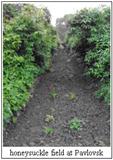
The Institute scientists and the Global Crop Diversity Trust (an organization working worldwide to preserve plant diversity) are now fighting a last ditch battle to save the second of the two plots being taken over. In December 2009, Russia's ministry of economic
development handed two of the station's land sites to the Russian Housing Development Foundation.
The institute's scientists appealed against the decision, but the courts ruled against them and a first plot, about a fifth of the station, will soon be put on sale for property development. The decision about a second, larger plot, of the 11th of August 2010
has also gone against the Centre and now the matter hinges on the good sense of the Russian President.
The signature campaign by the Trust has surely been a major motivator and it does appear that once the importance of Pavlovsk is understood, its enormity of the loss it were destroyed would be realized. The Trust has appealed to all concerned with the welfare
of the earth to join in the barrage or petitions, at it website.
"No country is self-reliant, in terms of having the diversity it needs now and certainly will need in the future, for breeding a variety of crops," says Cary Fowler, director of the Trust.
"Breeding is an ongoing activity because pests and diseases are always evolving and the climate is changing. We're always trying to make more productive, drought-tolerant and heat-resistant crops.
"This is the raw material for doing all of that - particularly with the changing climate. The biological resources conserved in one country could be very valuable to another country, another continent.
"We're all interdependent and that's why this unfolding tragedy at Pavlovsk is a concern to people outside Russia as well."
(the writer can be contacted at simplescience@gmail.com)
Note:
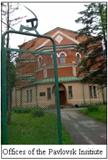
The Vavilov Institute of Plant Industry still maintains one of the world's largest collections of plant genetic material. The Institute began as the Bureau of Applied Botany in 1894, and was reorganized in 1924 into the All-Union Research Institute of Applied
Botany and New Crops, and in 1930 into the Research Institute of Plant Industry. Vavilov was the head of the institute from 1921 to 1940. In 1968 the institute was renamed after him in time for its 75th anniversary.
By 1940, Vavilov had accumulated a collection of 200,000 plant seeds from the Soviet Union and from abroad. Most of his genetic samples were seized by a German collecting command set up in 1943, and were transferred to the SS Institute for Plant Genetics, which
had been established at the Lannach Castle near Graz, Austria. However, the command could only take samples stored within the territories occupied by the German armies, mainly in Ukraine and Crimea. The main gene bank in Leningrad (now St Petersburg) was not
affected. The leader of the German command was Heinz Brucher, an SS officer who was also a plant genetics expert.
During the Siege of Leningrad in World War II, the Pavlovsk Station was isolated and had no access to food supplies. 12 Russian scientists who were trapped in the Station chose to starve to death, though they were surrounded by seeds of rice, corn, peas and
wheat, which could have saved them.
|
Eco-travel

Discounted Inaugural offer to visit Kanha National Park (Madhya Pradesh)
Offer valid for bookings made for the period between 15th Oct to 15th Nov 2010
Last date for booking 15th October 2010! Offer valid for registered members of IndianWildlifeClub.com only.
Kanha Village Camp, Kanha, is 16 kms from Mukki Gate of Kanha national Park on Balaghat road. Spread over 32 acres of private forest, the resort is offering an exclusive promotional offer to IndianWildlifeClub.com members.
Three days standard itinerary
2 Nights/ 3 days stay charges
Plus
Meals (Breakfast-Lunch-Dinner)
Pick up and drop facility from Gondia Station and back
Two visits to Kanha National Park
Rs 18400/- per batch of six persons
Day 1
6 am
Arrive at Gondia Station by morning train & Refresh
at Hotel (two hours )
8-8.30 am
Breakfast at Resort
8.30-1.30 pm
Reach Kanha Village Camp and leisure time
1.30-2.30 pm
Lunch
5 pm
Visit to Museum and Interpretation Center
8.30 pm
Dinner and free time for socializing
Day 2
5 am
Visit to Kanha National Park early morning*
7.30 am
Breakfast on route (Packed)
2 pm
Back to Resort after visit and Lunch
6.30 pm
Cultural Programs
9 pm
Dinner
Day 3
5.30 am
Nature walk and bird watching
8 am
Breakfast and leisure time for socializing
12.30-1.30 pm
Lunch and leave back home
*The second trip to the National Park can be the same day evening or next day morning as per the convenience of tourist but has to be intimated along with booking.
Assumptions :
Group size in multiples of six travelers.
Package for 3 days on double / triple sharing basis.
50% advance at the time of booking and balance 50% at the time of departure.
This is only one time inaugural offer.
Booking confirmation on or before 15th October 2010.
Hurry and book by
clicking here
|
Events
Worldwide Save Loktak Lake Campaign
Time September 26 · 3:00pm - 6:00pm
Location Washington, Bangalore and Chennai
Worldwide Save Loktak Lake Campaign
Organised by: NECEER, Imphal
25 cities in 3 continents
The campaign is two year long awareness programme initiated by NECEER, Imphal for the conservation of Loktak Lake. More than 600 volunteers, 32 city Coordinators, Publicity Coordinator and 1 Worldwide Coordinator are involved in organizing this campaign.
For more details about joining the campaign see
http://www.facebook.com/profile.php?id=100001023541401#!/event.php?eid=140495335967053&index=1
Wildlife Sanctuaries of Goa - Biodiversity Hotspots of the Western Ghats
Time October 1 at 10:30am - October 4 at 4:00pm
Location GOA
During this camp, we will be exploring Mhadei Wildlife Sanctuary, Bhagwan Mahavir Wildlife Sanctuary and Bondla Wildlife Santuary. The region has been acknowledged as a Mega Biodiversity Hotspot of the Western Ghats Range and has also been recognized as an
Important Bird Area.
Dates : 1th - 4th October 2010 (Second Batch)
Accommodation : Wildernest Resort (4 star category)
Please check the website: www.wildernest-goa.com
For more details about joining the trip see
http://www.facebook.com/profile.php?id=538046100&v=app_2344061033#!/event.php?eid=135680566468748&index=1
Photographer Workshops
March 2011
Tanzania, Africa - The Ultimate Africa Experience
This photographic safari will be conducted in the east African country of Tanzania, home to the Serengeti National Park, the Ngorongoro Crater and Mount Kilimanjaro. It will combine an exciting photography workshop in one of the world's most outstanding wildlife,
birding, landscape and cultural locations together with a luxury vacation in fascinating Tanzania.
Dates: March 1, 2011 - March 12, 2011
Location: Tanzania, Africa
Instructor: Greg Downing
Participants: 10 - Selling Fast!
http://www.naturescapes.net/docs/index.php/workshops
May 2011
Kauai, Hawaii - Ultimate Kauai - from Land, Sea, and Air
Join NatureScapers.net co-founders Greg Downing and E.J. Peiker on the ultimate photo tour of Kauai. During this tour we will explore this island like no other photo tour can. With the combined experience of Greg and E.J. in all genres of nature photography,
you will be assured in coming home with once in a lifetime images of Hawaii's oldest and greenest major island.
Dates: May 24, 2011 - May 30, 2011
Location: Kauai, Hawaii
Instructors: Greg Downing, E.J. Peiker
Participants: 7
http://www.naturescapes.net/docs/index.php/workshops
August 2011
St. Paul Island, Alaska - Puffins and More Adventure
This exciting adventure takes us to the tiny remote island of St. Paul in Alaska’s Pribilofs. Situated in the Bering Sea, St Paul Island attracts hundreds of thousands of seabirds to nest in its vertical cliffs, and the majority of the world’s population of
Northern Fur Seals to bear and raise young on its shores.
Dates: August 5, 2011 - August 12, 2011
Location: St. Paul Island, Alaska
Instructors: Greg Downing, Alan Murphy
Participants: 12
http://www.naturescapes.net/docs/index.php/workshops
BNHS programs in September
TREK to RAJMACHI
Nature trek to Rajmachi. Situated on the crest of the
Sahyadris, Rajmachi is famous with trekkers for its
lush green cover and scenic beauty. Here, there are
two forts namely 'Shrivardhan' and 'Manoranjan'.
During the climb, one can see the fascinating caves of
Kondivade. Caves harbour colonies of Lesser False
Vampire Bat. The climb is usually accompanied by the
“school boy’s whistle” of the Malabar whistling
Thrush.
More details at
http://www.facebook.com/event.php?eid=151271061563350
Kaas - Maharashtra’s very own "Valley of Flowers"
September 25 at 6:30am - September 26 at 7:30pm
Kaas, Near Satara
Kaas is popularly known as the Valley of Flowers of Maharashtra. This plateau is situated about 22 km from the Satara. Visited in right season, Kaas has an enchanting view of carpets of flowers of different shades. One can see a variety of orchids like the
Habenaria, orange carpets of Murdania, violet-blue carpets of Bladderwort and pink carpets of Balsam – such is a spectacular sight at Kaas. Birds like Malabar Lark, Common Bu...zzard, Bonelli’s Eagle and Crested Bunting are also seen. Kaas is a perfect place
for nature photographers. Stay will be in Satara.
Camp Charges: Rs. 3500/- .
Reporting: Bus will leave from Goregaon East (Oberoi Mall) at 5.45 am, 6.30 a.m. from Dadar, (near Chandu Halwai), 6.50 a.m. from Chembur, (near Diamond Garden) and Vashi Junction at 7.10 a.m.
Group leaders: Mr. Vandan Jhaveri & Mr. Hemant Tripathi.
Note: - Room sharing will be separate for male and female participants.
Registration*: Call at Hornbill House 22821811 or e-mail at bnhs.programmes@gmail.com
www.bnhs.org
More details at
http://www.facebook.com/profile.php?id=538046100#!/event.php?eid=148694991830728&ref=mf
WALK FOR CONSERVATION
September 19 · 7:00am - 10:00pm
Sanjay Gandhi National Park, Borivali, Mumbai
Walking to the SNGP to walk to the unexplored location and talking about conservation of Wildlife, Photography .
Register yourself with ur name and the number of people on 7620888899(Vipul Surana)
More details at
http://www.facebook.com/profile.php?id=538046100#!/event.php?eid=148169211881580&ref=mf
FEEL @ HOME in Public Transport
Time
September 19 · 3:30pm - 11:30pm
Location Chirag Dilli BRT, New Delhi
Created By
Urban Gorillaz - Agents of Change
More Info 10 cities around the world will learn how to "FEEL @ HOME" while using public transportation. So will Delhi. Come out on Sunday 19th Sept. at 3:30 pm at the Chirag Dilli BRT , where Delhi's youth will flaunt its will. WEAR RED, and get your coffee
mugs/pillows/bean bags or anything symbolic of being at home. More details would reach you once you fill the following form.
https://spreadsheets6.google.com/embeddedform?formkey=dFUxSHhKalBYMGltd2NucXFRMGk3Vnc6MQ
Please join us in spreading this word in Delhi by signing up and more importantly SHOWING UP for some fun while making a difference!
For more details please see -
http://www.youthforpt.org/?p=2592
|
General
Do you have a website or a blog?
If you do, please display the blue or green button on your site.


To display the button, please cut and paste the following 'html' code on your site/blog.
For blue button
<a href="http://www.indianwildlifeclub.com"><img border="0" alt="Indianwildlifeclub.com" width="88" src="images/blue.gif"
height="31"/></a>
For green button
<a href="http://www.indianwildlifeclub.com"><img border="0" alt="Indianwildlifeclub.com" width="88" src="images/green.gif" height="31"/></a>
Let us be proud to be part of IndianWildlifeClub.com, the community for nature lovers who care.
Thank you.
Team IWC
|